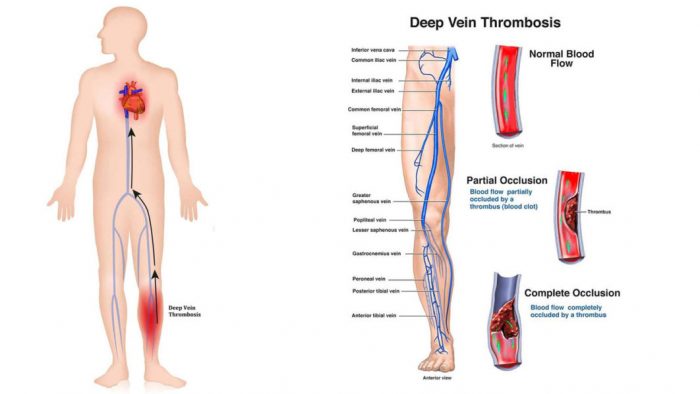What to know about thrombosis
What is Thrombosis and circumstances that can lead to it?
Thrombosis simply means formation of clots within the blood vessels. Blood within the blood vessel is supposed to be in a ‘fluid-state.’ So, when blood clots within a vessel, its bad news. Clots can form within veins or arteries. Thrombi or clots occur in veins, when there is interplay between three factors, which include, hypercoagulability, sluggish or slow blood flow through the blood vessel and damage to the blood vessel. This is referred to as the ‘Virchow’s triad.’ Depending on their location, clots can cause blockage of blood flow leading to tissue death or they could get dislodged and carried to other parts of the body, where they cause serious harm.Deep Vein Thrombosis or DVT is a serious condition that occurs, when clots form within the deep vessels of the body, most commonly, the leg or thigh, arms, but can occur anywhere in the body.
What are the first signs of DVT?
The most common site for DVT is the leg and symptoms include, pain (especially in the calf), swelling in one leg with warmth of the skin around the area affected and reddish or bluish discoloration of the affected area. In about half of the cases of DVT, there may be no symptoms and the diagnosis is made after a patient presents with features of pulmonary embolism (PE), which is a dreaded complication of DVT that is potentially fatal.
PE usually occurs, when a clot is dislodged and is carried to the lungs, where it blocks the pulmonary artery, causing reduced blood flow to the lungs. Patients often present with shortness of breath, chest pain and coughing up blood. It is a very serious condition that may lead to death, if prompt intervention is not taken.
Is it hereditary?
DVT is not hereditary, but there are some hereditary or genetic conditions that increase the risk of developing DVT.
What are the risk factors for DVT?
DVT may occur in any condition that is associated with the factors that increase the risk of developing DVT in that person (Virchow’s triad). These conditions include, but are not limited to, prolonged periods of immobility e.g. after major surgeries, long distance travels, obesity, trauma, smoking, pregnancy, positive family history of DVT, combined oral contraceptive pills, hormone replacement therapy, cancer, etc.
In addition to the above, there are some inherited disorders that predispose to the development of DVT, especially when they occur in the presence to some of the conditions mentioned above. Such inherited disorders include, Factor V Leiden mutation, proteins C and S deficiency (these are naturally occurring anticoagulants) and Antithrombin III deficiency, among others.
Does it limit one’s mobility?
Depending on the severity and location of the thrombus, DVT may limit mobility, especially in the presence of severe pain and swelling.
Can it be treated?
Yes, DVT can be treated. Treatment of DVT is aimed at preventing the clot from growing bigger, preventing other clots from forming and preventing PE (Pulmonary embolism). Drugs called anticoagulants, also known as ‘blood thinners’ are used for treatment of DVT. These may be intravenous (unfractionated heparin, low molecular weight heparin) or oral (warfarin, dabigatran, rivaroxaban, etc.).
These drugs don’t break up existing clots, but prevent other clots from forming, while the body takes care of the already formed clot. In severe cases, drugs that directly break the clots may be used. These are called thrombolytic agents and are usually given intravenously or directly on the clot through a catheter. Patients on these drugs have to be monitored, as they may cause bleeding.
Another way of treating DVT includes the use of filters in large veins that can prevent the clot from travelling to the lungs. Sometimes, compression stockings are used, especially for post-DVT complications.
Measures should be taken to prevent DVT, especially in settings known to increase the risk of its development. For example, for people that are going to have major surgeries, there should be a plan for administration of prophylactic anticoagulants after the surgery and to also encourage early mobilisation. People travelling long distances, for instance by air, should ensure they move around the plane, do leg exercises and drink lots of fluid.
What are lifestyle habits to adopt to reduce risk of developing DVT?
By engaging in regular exercise, not smoking, keeping a healthy weight and diet. Females should seek advice from a doctor on the type of contraception to use. All doctors should be aware of procedures or interventions that could predispose to DVT and take appropriate preventive measures. Anyone that has symptoms suggestive of a DVT should immediately see a doctor.








